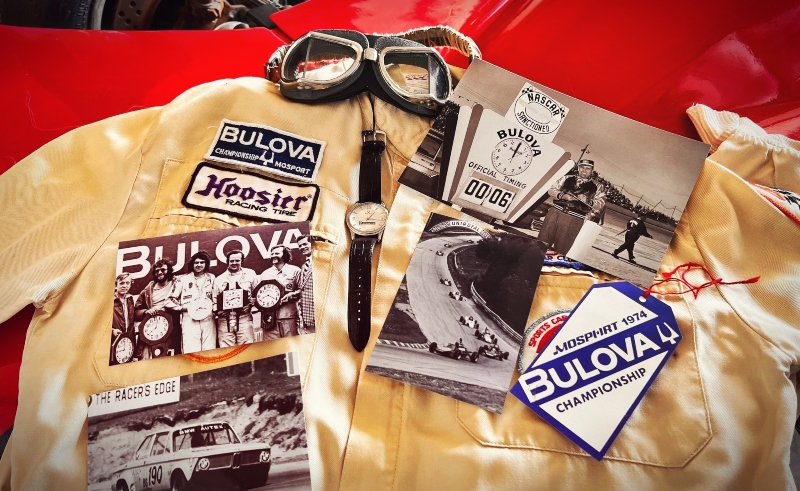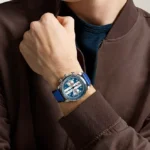When most people think of motorsports watches, major brands like Rolex, Tag Heuer, and Yema spring to mind, but Bulova, a watch brand with a 146-year history, isn’t one that most automotive enthusiasts connect with motorsports despite the watchmaker having a rich history racing. In the 1940s-1960s, if you were at an American motorsports event, it is likely that Bulova was involved. But before we get into the motorsports heritage, we should look at the overall history of Bulova.
Founded in 1875 in Queens, Bulova rose to become one of the largest and most innovative watchmakers in the world. Manufacturing watches both in the US and Switzerland, by 1919 the company offered a range of watches for women and men. Always innovative, Bulova became the first advertisement ever broadcast on radio in 1926, announcing, ‘At the tone, it’s eight o’clock, Bulova Watch Time’; the announcement was heard by millions of Americans. Bulova would also broadcast the first-ever television ad in 1941 before a baseball game between the Brooklyn Dodgers and Philadelphia Phillies over New York station WNBT. est card modified to look like a clock with the hands showing the time. The Bulova logo, with the phrase “Bulova Time”, was shown in the lower right-hand quadrant of the test pattern while the second hand swept around the dial for one minute.
In 1927, Charles Lindbergh made history by crossing the Atlantic nonstop, in addition to worldwide fame and a check for $1,000, he would receive a Bulova watch. Lindbergh would go on to be a spokesman for the Bulova, and the brand even created a special “Lone Eagle” model featuring the aviator. Bulova game clocks were installed in sports arenas such as Boston Garden, Chicago Stadium, and the Detroit Olympia in the 1940s; one was still in use until 1976 in Chicago.
The 1960s would see the development of the Accutron watch, which used a 360 Hz tuning fork instead of a balance wheel for timekeeping. The Accutron kept time better than mechanical watches of the time and was the modern forerunner of the quartz movement. While Omega is known as the “first watch on the moon,” the other “moon watch” is the Bulova Chronograph Model #88510/01, which was a prototype and the only privately owned watch to ever be worn on the Moon. In 2015, the watch sold at auction for $1.625 million, prompting Bulova to release a commemorative edition in 2016.
In 2008, Citizen bought Bulova Watch Company for $250 million dollars, but while Citizen embraces its motorsports connections, Bulova has not done much in promoting its motorsports heritage, and tracking down the history of Bulova racing has been much more complicated than you might think. My research has led me to buy photo negatives from the 1960s and 70s, vintage magazines, and even several watches related to Bulova’s history in motorsports over the years.
The earliest motorsports reference I could find was from a newspaper story about racer Mike Salay winning a Bulova Ranger for a race in 1941 in the midwest. In a 1950 news article Chevrolet and Bulova provided the winners of a Soap Box Derby with a watch, the dial stamped in red “13th ALL-AMERICAN SOAP BOX DERBY” The company would continue this tradition well into the 1980s from what I have been able to find, in my collection is a championship watch from the 1982 Soap Box Derby.
In a photo, I was able to date back to 1957, NASCAR used Bulova as their official timing partner, but after several calls to the NASCAR Hall of Fame and other NASCAR historians, no one could produce any clear answers on the Bulova partnership or how long it lasted or if we should be looking for late 50s Bulova timepieces that were given to race winners. Bulova ran advertisements in major magazines like Popular Science, New York Magazine, and Playboy featuring race car drivers holding up their wrists to show off their Bulova watches which ranged from $25-$2,500 according to the ad (above).
In a photo from the 1967 12 hours of Sebring (above), Carroll Shelby is seen wearing a Bulova Accutron Astronaut on a stainless steel bracelet. Carroll was also photographed wearing a two-tone Rolex in the 1960s, but few details on that watch are available. I decided to look up what they used for the film Ford v Ferrari, but it isn’t a Bulova, instead, Matt Damon as Carroll Shelby wears a Heuer Carrera 7753SN. The movie also got Ken Miles’s watch wrong, in the film he wears a Heuer Autavia ref. 2446, but he was known for wearing a Breitling Co-Pilot Chronograph, but that is Hollywood for you.
The 1970s would see the company’s most involvement in motorsports with the Bulova sponsoring a 1972-1976 Formula Ford series, the Mosport Park Championship in Canada. The winner of the series would win a Bulova clock, a watch, and a chance to race in England the following year. To accompany the open wheels cars, a sedan series ran alongside, but those drivers didn’t win a trip to England. Most of the negatives I was able to purchase highlighted the sedan series some of which I printed if they showed the Bulova decals.
Champions of the Bulova Formula Ford Series:
- 1972 Luke deSadeleer
- 1973 Danny Burritt
- 1974 Luke deSadeleer
- 1975 David White
- 1976 Alec Purdy
British GT racing driver David McDonald and his Ginetta G55 were sponsored by Bulova in 2011, as part of the brand’s push into the UK market. In 2016, Bulova featured another British racing driver Jordan King in a series of videos, driving a Mercedes-Benz Formula 3 car in full Bulova livery around Silverstone. The ads were promoting the Bulova Curv watch, but it doesn’t appear that they actually sponsored any Formula 3 cars.
Outside of these minor engagements with racing drivers in the UK, the brand hasn’t been involved in the world of motorsports in over six years, even though their current lineup of watches could easily be marketed to a new generation of automotive and watch enthusiasts. The Marine Star Series C, the classic Parking Meter, Lunar Pilot, Chronograph C, and the Chronograph A, series all have the right functions and style for motorsports, and all are well under $1,000. The most expensive watch in the Bulova lineup is the Precisionist X Limited Edition, at $3,950 which includes an impressive list of features and was limited to just 100 units.
Will Bulova make a return to motorsports? I hope so, with such a rich history and great product line it is surprising more automotive enthusiasts aren’t wearing Bulova. While I enjoy my collection of Bulova racing memorabilia and have a few of their watches in my collection, if they want to swap out the Tudor livery for Bulova on my vintage formula SV1600, I would be open to talking.






.jpg)


















